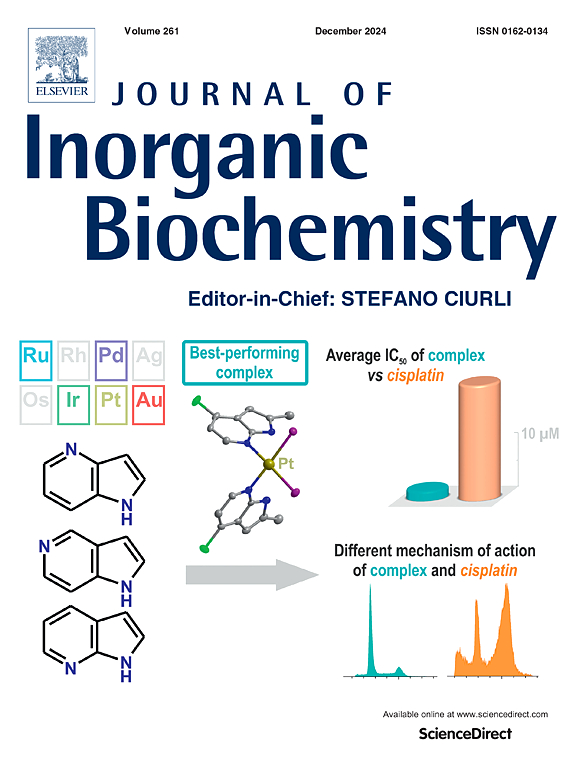Monomeric class II chelatase with four histidine residues at the active site, designated Mch4 chelatase, shows evolutionary trails from ancestral to descendant-types
IF 3.2
2区 化学
Q2 BIOCHEMISTRY & MOLECULAR BIOLOGY
引用次数: 0
Abstract
Class II chelatases catalyze the insertion of divalent metal ions into tetrapyrroles during the biosynthesis of metal-tetrapyrroles, and are regarded as standard models for investigating chelation mechanisms. The catalytic core of class II chelatases exhibits either a homodimer- or a monomer-type architecture with similar overall folds and different catalytic His residues: four His residues in the homodimer type and one or two His residues in the monomer type. These structural features of the two types of chelatases have led to the hypothesis that the monomer-type is a “descendant” evolved from the homodimer-type “ancestor”. However, there has been no report on naturally-occurring “evolutionary intermediate”-type of chelatases to support this hypothesis. Here, we show the discovery and characterization of such “evolutionary intermediate”-type chelatases. Because this type of chelatases was classified into monomeric chelatases with four histidine residues at the active site, we named these chelatases Mch4. Gene complement analysis showed Mch4s could play a role in Fe2+ insertion into sirohydrochlorin. Notably, Mch4s did not utilize coproporphyrin III or protoporphyrin IX in vivo assay. In addition, in vitro functional analysis of Mch4s demonstrated that they could utilize Ni2+, Co2+ as well as Fe2+ insertion into sirohydrochlorin. These findings suggest that nickel chelatase activity with sirohydrochlorin was maintained in the hypothetical class II chelatase evolution from homodimeric ancestor-type, to monomeric evolutionary-intermediate-type Mch4, followed by changes in the metal and tetrapyrrole preferences of some descendant chelatases through further evolution, such as further substitution of His at their active sites.

活性位点有四个组氨酸残基的单体II类螯合酶,称为Mch4螯合酶,显示了从祖先到后代型的进化轨迹
在金属四吡咯的生物合成过程中,II类螯合酶催化二价金属离子插入到四吡咯中,被认为是研究螯合机制的标准模型。II类螯合酶的催化核心具有同型二聚体或单体型结构,具有相似的总体折叠和不同的催化His残基:同型二聚体中有四个he残基,单体中有一个或两个he残基。这两种螯合酶的结构特征导致了一种假设,即单体型是同源二聚体型“祖先”进化而来的“后代”。然而,没有关于自然发生的“进化中间”型螯合酶的报道来支持这一假设。在这里,我们展示了这种“进化中间”型螯合酶的发现和表征。由于这种类型的螯合酶被归类为活性位点有四个组氨酸残基的单体螯合酶,我们将这些螯合酶命名为Mch4。基因补体分析表明,Mch4s可能在Fe2+插入到sirohydrochlorin中起作用。值得注意的是,在体内实验中,Mch4s没有使用卟啉III或原卟啉IX。此外,Mch4s的体外功能分析表明,它们可以利用Ni2+、Co2+和Fe2+插入到sirohydrochlorin中。这些发现表明,在假设的II类螯合酶从同源二聚体祖先型进化到单体进化-中间型Mch4的过程中,镍螯合酶与sirohydrochlorin的活性保持不变,随后一些后代螯合酶在进一步进化中对金属和四吡啶的偏好发生了变化,例如在其活性位点进一步取代His。
本文章由计算机程序翻译,如有差异,请以英文原文为准。
求助全文
约1分钟内获得全文
求助全文
来源期刊

Journal of Inorganic Biochemistry
生物-生化与分子生物学
CiteScore
7.00
自引率
10.30%
发文量
336
审稿时长
41 days
期刊介绍:
The Journal of Inorganic Biochemistry is an established international forum for research in all aspects of Biological Inorganic Chemistry. Original papers of a high scientific level are published in the form of Articles (full length papers), Short Communications, Focused Reviews and Bioinorganic Methods. Topics include: the chemistry, structure and function of metalloenzymes; the interaction of inorganic ions and molecules with proteins and nucleic acids; the synthesis and properties of coordination complexes of biological interest including both structural and functional model systems; the function of metal- containing systems in the regulation of gene expression; the role of metals in medicine; the application of spectroscopic methods to determine the structure of metallobiomolecules; the preparation and characterization of metal-based biomaterials; and related systems. The emphasis of the Journal is on the structure and mechanism of action of metallobiomolecules.
 求助内容:
求助内容: 应助结果提醒方式:
应助结果提醒方式:


